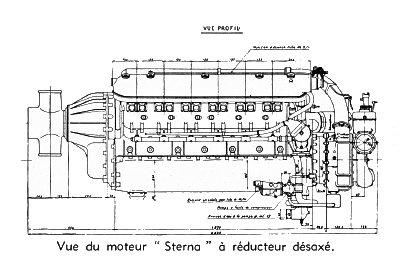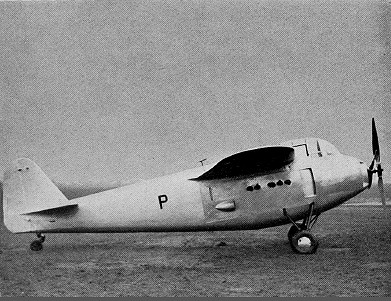NEW ADAPTATIONS.
To further expand the possibilities of the STERNA engine and to study in real life a number of improvements or modifications developed by the Research and Studies Department
of the S.N.C.M. this engine gave rise to the following achievements:
1. STERNA WITH RIGHT OR LEFT INTERCHANGEBLE REDUCTION GEAR.
- The reversing torque to which multi-engine airplanes are subjected, as a result of the propellers rotating in the same direction, has forced the manufacturers to
provide for port and starboard engines with different directions of rotation. This leads to a change in the engine of a number of parts (distribution, calibration of magnetos,
greasing, etc.), which hinders production of large series.
- The S.N.C.M. has achieved the reversal of the direction of rotation on the reducer itself. Always identical engines can receive either right or left gearboxes depending
on their location on the aircraft, which facilitates the installation, maintenance and supply of spare engines in training.
- In addition, S.N.C.M. develops a propeller-casing link that can, in the event of a break in flight of key parts, such as the crankshaft, to avoid major damage to the propeller
and, consequently, to the aircraft.
2.; STERNA WITH OFF-CENTER REDUCTION GEAR.
- The equipment of the fighter planes with a gun firing through the axis of the fuselage led the S.C.N.M. to realize an off-center helical gearbox allowing the barrel tube to
pass through the axis of the propeller.
- This reduction gear has, on the other hand, the advantage of raising the axis of the propeller and, therefore, reduce the height of aircraft landing gear.
- The S.C.N.M. equipped the STERNA engine with an off-center gearbox and a gear ratio of 21/34, giving this engine the possibilities of use on fighter planes.
3. STERNA WITH 2-SPEED SUPERCHARGER.
- The need to maintain a high level of power in the vicinity of the ground for heavily loaded aircraft engines at take-off has led manufacturers to build multi-stage superchargers.
- In this sense, the S.C.N.M. realized a two-stage, two-speed supercharger that would restore, in principle, a power of 900 hp. at 1,800 m. and a power of 850 hp. at 4,500 m.
with multiplication ratios respectively of 5.14 and 8.8.
- This method thus allows a power range corresponding precisely to the requirements of modern aircraft of all types.
4. STERNA WITH FUEL INJECTION AND HIGH YIELD PLANIOL SUPERCHARGER.
- The design of the supercharger and its principle play a very important role in the supply and performance of supercharged aircraft engines. The S.N.C.M. for this purpose carries out
very extensive tests of a STERNA engine equipped with a PLANIOL supercharger with guide vanes.
- At the same time, studies on direct fuel injection by SOCIÉTÉ LORRAINE have been actively pursued on this same engine, the PLANIOL supercharger responding perfectly
to this mode of supply.
- We know all the advantages of direct fuel injection pump controlled by the engine. The filling being better carried out, the consumption is diminished in notable proportions.
In addition, the altimetric correction and the engine feeding in reverse position during aerobatics are greatly facilitated. The risk of carburetor icing, as well as the risk of backfire,
are radically eliminated. But, above all, the fuel injection brings two significant advantages: the equality of richness between all the cylinders of the engine and the possibility of
internal cooling of the cylinder head and the piston by sweeping with fresh air.

View of the "Sterna" motor with offset gearbox. |
5. STERNA WITH REMOTE REDUCTION GEAR AND REMOTE PROPELLER TRANSMISSION.
- Continuing further research, S.N.C.M. studied the realization of a remote propeller shaft to meet the demand that it was made by aircraft manufacturers to move the propeller
away from the powertrain for the purpose of a better engine fairing.
- These advantages have been confirmed in the equipment of the KOOLHOVEN F.K.55 fighter plane, in which the LORRAINE STERNA engine occupies the center of the fuselage. The
propeller reduction gear being relocated 1 m. 50, driven by this arrangement to a profiling of lesser resistance for the fuselage.
- In addition, on this aircraft, the gearbox comprises the propulsion of two concentric axis propellers and rotating in the opposite direction, which has the effect of canceling
the reversal torque of the aircraft to the rotation of a single propeller.
FUTURE PROGRAM.
The SOCIÉTÉ NATIONALE DE CONSTRUCTION DE MOTEURS program of studies is not limited to the improvements just described.
The search for engines of the future with a high mass power and a small footprint compatible with a cooling assured in all flight conditions have led the Technical Department to study
engines with a power of 1,500 to 2,000 HP of a new design intended to allow the realization of engine-frames endowed with a very great finesse.
The study and the development of this engine is the object of a close liaison with the aircraft manufacturers. For this purpose, the Research and Studies Department has appointed Engineers,
who are themselves pilots and who, as such, can appreciate the servitudes specific to the aircraft and their reactions to the design of the engine.
It is thanks to this collaboration, that the SOCIÉTÉ NATIONALE DE CONSTRUCTION DE MOTEURS intends to push very far, that we can be sure to see Argenteuil workshops coming
out with the engines that will bring an important and new contribution to the future of aeronautical progress.

Koolhoven F.K. 55 airplane with Lorraine Sterna motor, with off-center gearbox with double propeller drive shaft. |
LES IMPRESSIONS BOUTIN - PARIS
10 000.11.38
Translated with Google Translate
http://fire.prohosting.com/uncommon/reference/france/19_new_en.html
Originally posted 27 December 2017
Modified: 12/27/2017


